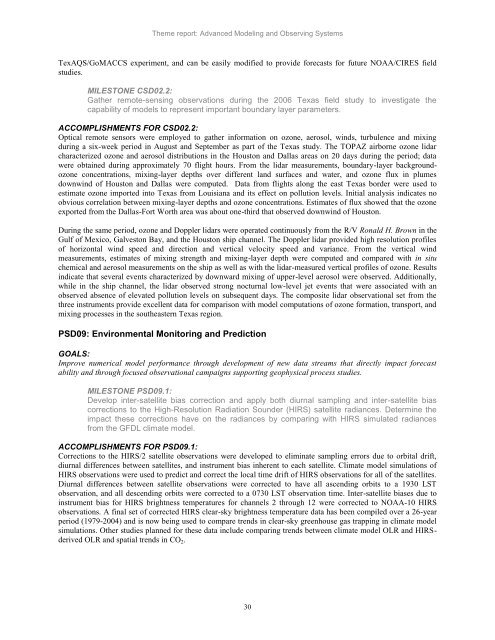Scientific Theme: Advanced Modeling and Observing Systems
Scientific Theme: Advanced Modeling and Observing Systems
Scientific Theme: Advanced Modeling and Observing Systems
Create successful ePaper yourself
Turn your PDF publications into a flip-book with our unique Google optimized e-Paper software.
<strong>Theme</strong> report: <strong>Advanced</strong> <strong>Modeling</strong> <strong>and</strong> <strong>Observing</strong> <strong>Systems</strong><br />
TexAQS/GoMACCS experiment, <strong>and</strong> can be easily modified to provide forecasts for future NOAA/CIRES field<br />
studies.<br />
MILESTONE CSD02.2:<br />
Gather remote-sensing observations during the 2006 Texas field study to investigate the<br />
capability of models to represent important boundary layer parameters.<br />
ACCOMPLISHMENTS FOR CSD02.2:<br />
Optical remote sensors were employed to gather information on ozone, aerosol, winds, turbulence <strong>and</strong> mixing<br />
during a six-week period in August <strong>and</strong> September as part of the Texas study. The TOPAZ airborne ozone lidar<br />
characterized ozone <strong>and</strong> aerosol distributions in the Houston <strong>and</strong> Dallas areas on 20 days during the period; data<br />
were obtained during approximately 70 flight hours. From the lidar measurements, boundary-layer backgroundozone<br />
concentrations, mixing-layer depths over different l<strong>and</strong> surfaces <strong>and</strong> water, <strong>and</strong> ozone flux in plumes<br />
downwind of Houston <strong>and</strong> Dallas were computed. Data from flights along the east Texas border were used to<br />
estimate ozone imported into Texas from Louisiana <strong>and</strong> its effect on pollution levels. Initial analysis indicates no<br />
obvious correlation between mixing-layer depths <strong>and</strong> ozone concentrations. Estimates of flux showed that the ozone<br />
exported from the Dallas-Fort Worth area was about one-third that observed downwind of Houston.<br />
During the same period, ozone <strong>and</strong> Doppler lidars were operated continuously from the R/V Ronald H. Brown in the<br />
Gulf of Mexico, Galveston Bay, <strong>and</strong> the Houston ship channel. The Doppler lidar provided high resolution profiles<br />
of horizontal wind speed <strong>and</strong> direction <strong>and</strong> vertical velocity speed <strong>and</strong> variance. From the vertical wind<br />
measurements, estimates of mixing strength <strong>and</strong> mixing-layer depth were computed <strong>and</strong> compared with in situ<br />
chemical <strong>and</strong> aerosol measurements on the ship as well as with the lidar-measured vertical profiles of ozone. Results<br />
indicate that several events characterized by downward mixing of upper-level aerosol were observed. Additionally,<br />
while in the ship channel, the lidar observed strong nocturnal low-level jet events that were associated with an<br />
observed absence of elevated pollution levels on subsequent days. The composite lidar observational set from the<br />
three instruments provide excellent data for comparison with model computations of ozone formation, transport, <strong>and</strong><br />
mixing processes in the southeastern Texas region.<br />
PSD09: Environmental Monitoring <strong>and</strong> Prediction<br />
GOALS:<br />
Improve numerical model performance through development of new data streams that directly impact forecast<br />
ability <strong>and</strong> through focused observational campaigns supporting geophysical process studies.<br />
MILESTONE PSD09.1:<br />
Develop inter-satellite bias correction <strong>and</strong> apply both diurnal sampling <strong>and</strong> inter-satellite bias<br />
corrections to the High-Resolution Radiation Sounder (HIRS) satellite radiances. Determine the<br />
impact these corrections have on the radiances by comparing with HIRS simulated radiances<br />
from the GFDL climate model.<br />
ACCOMPLISHMENTS FOR PSD09.1:<br />
Corrections to the HIRS/2 satellite observations were developed to eliminate sampling errors due to orbital drift,<br />
diurnal differences between satellites, <strong>and</strong> instrument bias inherent to each satellite. Climate model simulations of<br />
HIRS observations were used to predict <strong>and</strong> correct the local time drift of HIRS observations for all of the satellites.<br />
Diurnal differences between satellite observations were corrected to have all ascending orbits to a 1930 LST<br />
observation, <strong>and</strong> all descending orbits were corrected to a 0730 LST observation time. Inter-satellite biases due to<br />
instrument bias for HIRS brightness temperatures for channels 2 through 12 were corrected to NOAA-10 HIRS<br />
observations. A final set of corrected HIRS clear-sky brightness temperature data has been compiled over a 26-year<br />
period (1979-2004) <strong>and</strong> is now being used to compare trends in clear-sky greenhouse gas trapping in climate model<br />
simulations. Other studies planned for these data include comparing trends between climate model OLR <strong>and</strong> HIRSderived<br />
OLR <strong>and</strong> spatial trends in CO2.<br />
30
















